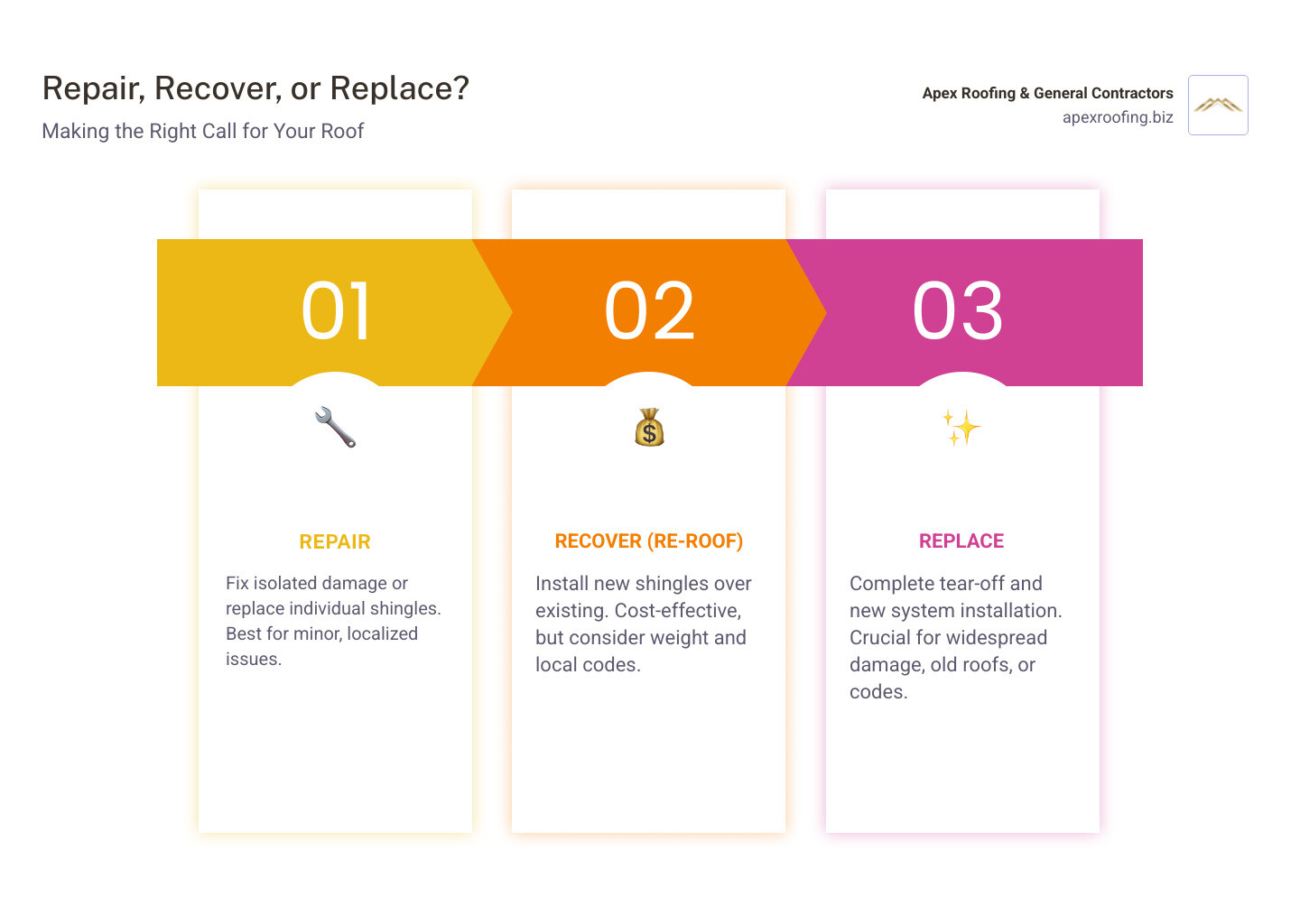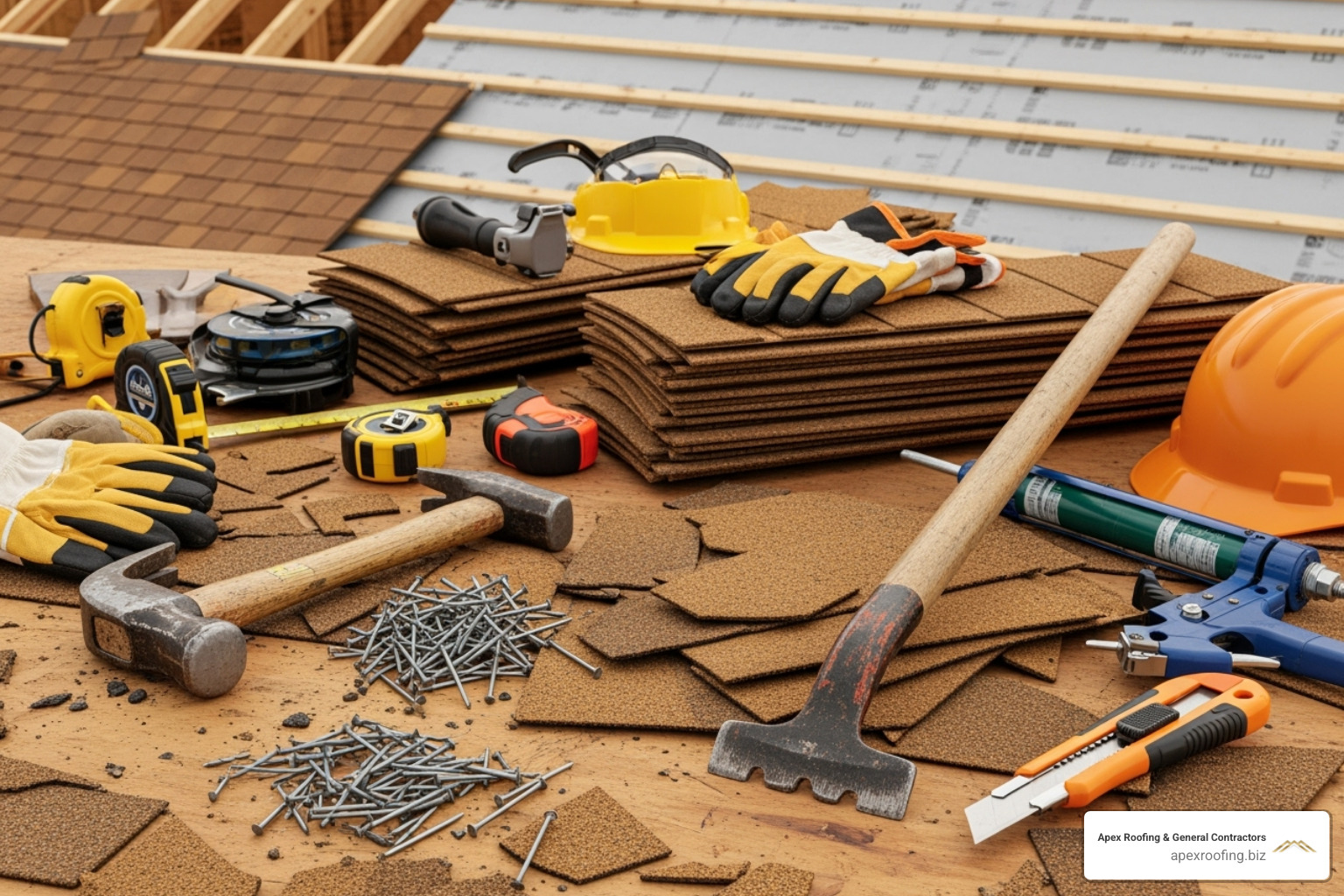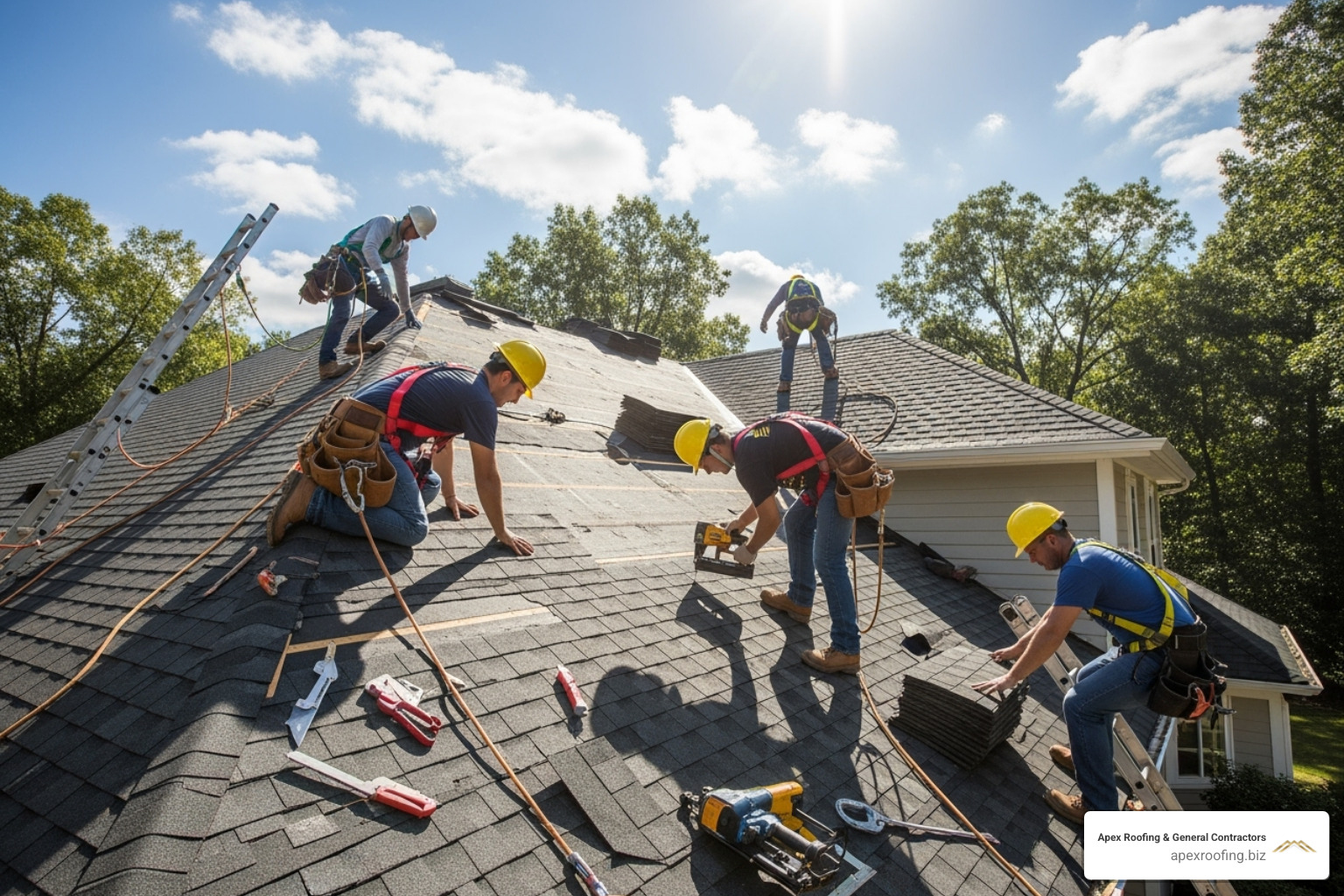Why Understanding Roof Shingle Replacement Options Is Critical for Your Home
Starting on a roof shingle replacement is a major investment in your home’s protection and value. When your roof shows signs of wear, understanding your options—repairing isolated damage, recovering with a new layer, or a full replacement—is key to making a sound decision. For homeowners seeking certified and reliable roofing services, knowing the process ensures a smooth project from start to finish. The right choice depends on your roof’s age, the extent of the damage, and local building codes, with costs for a full replacement typically ranging from $8,000 to $12,000.
This guide simplifies the process, helping you identify whether you need a simple fix or a complete overhaul. Making an informed choice about materials and contractors is crucial for your home’s long-term safety. For San Antonio homeowners, working with experienced roofing professionals ensures your project meets local codes and can withstand Texas weather.
I’m Carlos Yzaguirre, President of Apex Roofing & General Contractors. Since 2022, my team and I have specialized in delivering quality roofing solutions that provide lasting protection and peace of mind for homeowners and property managers throughout Texas.

Repair, Recover, or Replace? Making the Right Call

When your roof shows its age, deciding between a repair, a recover, or a full roof shingle replacement depends on several key factors. Roof age is a primary indicator; if your shingles are over 20 years old, even small issues can signal systemic failure. The shingle condition provides the clearest picture—are you dealing with a few loose shingles or widespread damage? Other red flags include granule loss, where protective granules collect in your gutters, and leaks or water damage, which can quickly escalate. Finally, the structural integrity is paramount; any sagging indicates a serious problem.
The choice between roof recovery versus replacement often hinges on local building codes and the condition of your roof deck. Many areas limit the number of shingle layers allowed. For detailed guidance on local codes, the NRCA offers comprehensive resources for homeowners.
Key Signs You Need a Roof Shingle Replacement
Learning to spot these warning signs can save you from costly emergency repairs:
- Curling or buckling shingles: These signs of age and wear compromise your roof’s ability to shed water.
- Widespread cracking: This indicates shingles have become brittle from sun exposure and can no longer expand and contract with temperature changes.
- Bald spots from granule loss: When the protective granule coating is gone, the underlying asphalt deteriorates quickly under direct sun and weather exposure.
- Moss or algae growth: While sometimes cosmetic, extensive growth often signals underlying moisture problems that trap water against shingles, causing rot.
- A sagging roof deck: This is a serious structural issue, often caused by water damage or the weight of too many shingle layers. It requires immediate professional attention.
- Roof is 20+ years old: Even if it looks acceptable, a roof nearing the end of its designed lifespan (15-25 years for 3-tab, 30-50 for architectural) is a candidate for replacement.
- Frequent repairs: If you’re constantly patching your roof, a replacement is often the more cost-effective long-term solution.
Understanding Roof Recovery (Re-roofing)
Roof recovery, or re-roofing, involves installing new shingles over old ones. The main benefit is cost savings, as it eliminates the labor and disposal fees of a tear-off. However, this method has significant drawbacks. Weight considerations are crucial, as most building codes limit roofs to two layers to avoid structural strain. Recovery is also not suitable for laminated shingles due to their uneven surface, which creates an unstable base.
Most importantly, you cannot inspect the deck condition underneath. Any existing rot or damage is simply covered up, potentially worsening over time. Furthermore, installing new shingles over old ones may void your shingle warranty and can lead to a reduced impact resistance rating. Always check local building codes, as recovery may not be a permissible option in your area.
Choosing Your Weapon: A Guide to Asphalt Shingles
For most roof shingle replacement projects, asphalt shingles are the go-to choice, covering over 70% of American homes due to their affordability, durability, and style versatility. Understanding the different types helps you balance cost, longevity, and aesthetics for your home.
Types of Asphalt Shingles
Let’s break down the three main types of asphalt shingles:
- 3-Tab Shingles: The most budget-friendly option, these shingles have a flat, uniform appearance and a lifespan of 15-25 years. While they offer basic wind resistance, they are a practical choice for rental properties or homeowners on a tight budget. Our team has extensive experience with installing 3-tab shingles and can help determine if they are right for you.
- Architectural Shingles: Also known as dimensional shingles, these are the most popular choice. Their multi-layered construction creates a dimensional appearance mimicking wood or slate. With a lifespan of 30-50 years and superior wind resistance, they offer an excellent balance of beauty and durability.
- Premium Luxury Shingles: These are the top-of-the-line option, designed to realistically imitate high-end materials like natural slate. They offer the best performance with lifespans of 40-50+ years and maximum wind and impact resistance. Their weight and cost are higher, but they provide unparalleled protection and prestige.
| Shingle Type | Cost (Relative) | Lifespan (Years) | Wind Resistance | Appearance |
|---|---|---|---|---|
| 3-Tab | Low | 15-25 | Basic | Flat, uniform |
| Architectural | Medium | 30-50 | Good | Dimensional |
| Premium/Luxury | High | 40-50+ | Excellent | High-end, sculpted |
Features to Consider
Modern asphalt shingles come with advanced features to boost performance:
- Algae Resistance: Technologies like StreakGuard use copper granules to prevent unsightly black streaks, which is especially useful in humid climates like San Antonio’s.
- Impact Resistance: A Class 4 rating offers the highest level of protection against hail and debris, which can lead to insurance discounts.
- Wind Warranties: Look for shingles rated for winds of 130 mph or higher, a crucial feature for storm-prone areas.
- Fire Ratings: A Class A fire rating provides the highest protection against external fires.
- Energy Efficiency: Cool roof shingles with reflective granules reduce heat absorption, which can lower energy bills in hot climates like Texas. You can explore energy-efficient options through ENERGY STAR®.
- Color and Style: A wide array of colors and textures are available to improve your home’s curb appeal and resale value.
The Complete Roof Shingle Replacement Process: A Step-by-Step Guide

Understanding the professional process for a roof shingle replacement helps you know what to expect. At Apex Roofing & General Contractors, we follow a methodical, multi-step approach to ensure your roof replacement delivers maximum protection. Each step builds on the last to create a durable, long-lasting roofing system.
Step 1: Preparation and Tear-Off
First, we protect your property by covering landscaping and outdoor furniture with heavy-duty tarps. A dumpster is strategically placed for efficient debris removal without damaging your driveway. The tear-off phase begins with removing all old shingles, underlayment, and nails. This messy but essential step exposes the roof deck, revealing its true condition. Throughout this process, our crews adhere to strict safety protocols, as outlined by resources like the OSHA safety equipment standards.
Step 2: Deck Inspection and Repair
With the deck exposed, we inspect every square foot for rot, warping, or damage. Any soft spots or weakened boards are identified. We then replace compromised decking with new plywood or OSB (Oriented Strand Board) to create a solid, nail-able surface. This step is critical, as installing a new roof over a faulty foundation will lead to future problems.
Step 3: Installing Underlayment and Flashing
Next, we install the roof’s protective layers. Drip edge is installed along eaves and rakes to direct water into the gutters. We then lay down water-resistant synthetic underlayment, which acts as a secondary barrier against moisture. In critical areas like valleys and eaves, we install an ice and water shield, a self-adhering membrane that prevents leaks from ice dams, a topic covered by the National Weather Service. Finally, we install new flashing around chimneys, vents, and skylights to redirect water away from these vulnerable penetration points.
Step 4: Installing the New Shingles
This is the final construction phase. We begin by installing starter strips along the roof edges for a clean line and added wind resistance. We then nail the new shingles according to manufacturer specifications to ensure performance and preserve your warranty. Proper overlapping and alignment are crucial for shedding water effectively. The shingles’ thermal sealant is activated by the sun, bonding the layers together. Finally, we install ridge cap shingles to protect the peaks and hips of the roof. For more details, you can review our guide on asphalt shingle installation.
DIY vs. Professional Roof Shingle Replacement

While the DIY spirit is admirable, a roof shingle replacement is a complex, physically demanding, and dangerous job that is very different from a typical weekend project. Before attempting this yourself, it’s important to weigh the risks against the benefits of hiring a professional.
When to Consider a DIY Approach
A DIY approach should only be considered for minor repairs, such as replacing one or two damaged shingles on an otherwise healthy roof. This is only advisable if you have genuine construction experience, all the proper safety equipment (harness, non-slip shoes, etc.), and a solid understanding of roofing principles. Be aware of the significant time commitment involved, as even small repairs can take longer than expected. If the underlayment is compromised or the roof is old, a simple patch is not an adequate solution.
Why Hiring a Professional is Often the Best Choice
For a full roof shingle replacement, hiring an experienced professional is the smartest and safest choice. Here’s why:
- Safety and Insurance: Roofing is a dangerous job. Professionals are trained in safety protocols and carry full liability insurance, protecting you from risk.
- Expertise and Efficiency: Experienced roofers can spot underlying issues and complete the job correctly and efficiently, avoiding costly mistakes common in DIY attempts.
- Access to Quality Materials: Professionals can source high-grade materials at better prices than what’s available at retail, ensuring better value.
- Warranty Protection: Reputable contractors provide warranties on both materials and workmanship, giving you long-term peace of mind.
- Code Compliance: A professional will ensure your project meets all local regulations in San Antonio and surrounding areas, which is crucial for home sales and insurance claims.
- Peace of Mind: Hiring a team lets you avoid the stress and danger of roofing work. You can learn more about our professional roof installation services and how we ensure a flawless result.
Frequently Asked Questions about Roof Shingle Replacement
How much does a roof shingle replacement cost?
The cost of a roof shingle replacement varies, but the national average is between $8,000 and $12,000. For most homes in the San Antonio area, the cost is typically around $10,000. Key factors influencing the final price include:
- Roof size and complexity: Larger roofs with steep pitches, dormers, and valleys cost more.
- Shingle type: Architectural and luxury shingles are more expensive than standard 3-tab shingles.
- Material quality: Premium underlayment and flashing will increase upfront costs but improve longevity.
- Labor and disposal: Tearing off the old roof adds to the total cost, as does any necessary deck repair finded during the inspection.
It’s always best to get detailed estimates from several reputable contractors.
How long does a shingle roof last?
The lifespan of your roof depends on the shingle type, installation quality, and local climate. Here are the general estimates:
- Standard 3-tab shingles: 15-25 years.
- Architectural shingles: 30-50 years.
- Premium luxury shingles: 40-50+ years.
In San Antonio, intense UV exposure and occasional severe weather can affect these lifespans. Regular maintenance is crucial to help your roof reach its maximum potential. Choosing the best season for your replacement can also ensure optimal installation conditions.
Can I install new shingles in the winter?
While a winter roof shingle replacement is possible, it’s not ideal. Cold temperatures make shingles brittle and susceptible to cracking during installation. More importantly, the sealant strips on the shingles require heat from the sun to properly bond and create a wind-resistant seal. Without adequate warmth, this process is delayed, leaving your new roof vulnerable to wind uplift.
Winter conditions also present safety concerns for the crew and can reduce efficiency. If a winter installation is unavoidable due to an emergency, professionals use special techniques to mitigate these issues. However, for the best results, it’s recommended to schedule your replacement for spring, summer, or fall. You can read more on installing shingles in winter for further details.
Conclusion
A roof shingle replacement is a vital investment in your home’s safety, value, and curb appeal. By understanding the signs of a failing roof, exploring your material options, and knowing the steps of a professional installation, you can make an informed decision that protects your property for decades.
We’ve covered the key indicators for replacement, from curling shingles to a sagging deck, and outlined the differences between repair, recovery, and a full replacement. We’ve also detailed the professional process, emphasizing that quality installation involves far more than just nailing down shingles—it requires expert deck inspection, underlayment, and flashing work.
While a DIY approach may seem cost-effective, the safety risks and complexity of roofing make hiring a certified professional the wisest choice. At Apex Roofing & General Contractors, we provide the expertise, warranties, and peace of mind you deserve. We understand the challenges of the San Antonio climate and are committed to delivering the highest standards of quality.
Ready to secure your home with a flawless new roof? Contact us for a free estimate and schedule your free inspection by calling (726) 727-7663 today.




